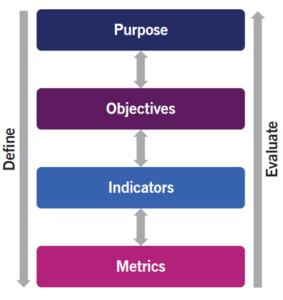One main topic of the ITIL Framework is “control”, that refers to the planning and improvement of activities. These are two specific aspects of the ITIL Value Chain.
In the ITIL Strategist Direct, Plan and Improve module there is more in-depth information on the topic of control and guidance to ITIL users.
Control: Definition and Influence
If we have to establish the direction of a Project, then we need to define what “control” is supposed to be. In ITIL there is the concept of “shared government”, which dispels the myth that government is only linked to the board of an organisation.
Leading an organisation can happen at many levels, and each one has different levels of authority. Indeed, each employee has a perimeter they govern, they have limited authority, direct the actions to take and define the results. ITIL emphasises that beyond the sphere of control, people also have a sphere of influence, which means that each person can influence the decisions made by others.
Control in ITIL Direct, Plan and Improve
ITIL recommends to design and implement a “goal cascade”. This cascade must start from the goals and objectives that we set for ourselves. What follows are the definitions of the necessary indicators and the metrics that will support them.

Control in ITIL DPI: How to Design a Goal Cascade
Often we start by using data-collection tools and collecting information that is not always useful. Instead, the ITIL Direct, Plan and Improve module teaches us to start from the objectives and then define the indicators and metrics.
The design of the Measurement System Cascade is from Purpose to Metrics. Of course, the measurement will then feed the Indicators through the Metrics, which will support the Objectives and finally the ultimate goal of our needs (Purpose).
Control in ITIL DPI: Decision-Making
So if it is true that it does not make sense that all decisions are taken at the same level, as it slows down the decision-making process, it is necessary to build a widespread authority, that is created by delegating as much as possible.
One way to do this is by using a metric cascade that provides the tools so that everyone can make the best decisions based on the information that they receive in regards to their level.
If the scope of control is too narrow it will lead to pushing decisions upwards, which is something that should be avoided. If, on the other hand, the control area is too broad, there is the risk of making strategic decisions at lower organisational levels.
Conclusion
On the one hand, restricted control leads to escalation and therefore longer times, on the other hand, less restricted control could lead to decisions with risks that are not carefully evaluated. We must therefore try to mitigate the risks by training people or providing guidelines so that decisions are aware and structured.
The ITIL Direct, Plan and Improve module provides the practical skills necessary to create an IT organisation in continuous improvement, with a strong and effective strategic direction. ITIL DPI provides a practical method to plan and implement continuous improvement with the necessary agility.
QRP International is an ATO (Authorised Training Organisation) for ITIL courses, find out more on our website or contact us!









